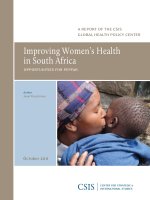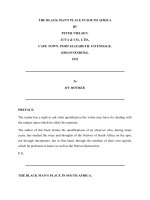Mapping ICT Access in South Africa pot
Bạn đang xem bản rút gọn của tài liệu. Xem và tải ngay bản đầy đủ của tài liệu tại đây (282.86 KB, 12 trang )
Free download from www.hsrcpress.ac.za
Mapping
ICT access in
South Africa
Kholadi Tlabela, Joan Roodt & Andrew Paterson
with Gina Weir-Smith
Free download from www.hsrcpress.ac.za
Published by HSRC Press
Private Bag X9182, Cape Town, 8000, South Africa
www.hsrcpress.ac.za
First published 2007
ISBN 978-0-7969-2182-6
© 2007 The Universal Service and Access Agency of South Africa
Cover design by Jacob Erasmus @ Compress
Production management Compress / www.compress.co.za
Distributed in Africa by Blue Weaver
Tel: +27 (0) 21 701 4477; Fax: +27 (0) 21 701 7302
www.oneworldbooks.com
Distributed in Europe and the United Kingdom by Eurospan Distribution Services (EDS)
Tel: +44 (0) 20 7240 0856; Fax: +44 (0) 20 7379 0609
www.eurospangroup.com/bookstore
Distributed in North America by Independent Publishers Group (IPG)
Call toll-free: (800) 888 4741; Fax: +1 (312) 337 5985
www.ipgbook.com
Tables and figures iv
Acknowledgements vi
Acronyms vii
Executive summary ix
1.2
1.3
Free download from www.hsrcpress.ac.za
1.1
The importance of access to information and communications technology
in South Africa 1
Universal ICT access and service in South Africa since 1994 2
Indicators of ICT access 3
2.1
2.2
2.3
Fixed telephone lines 8
Cellular subscribers 11
Community Service Telephones
3.1
3.2
Access to computers 21
Access to the Internet 24
4.1
4.2
4.3
4.4
Multi-Purpose Community Centres
Telecentres and Cyberlabs 36
Public Information Terminals 47
Libraries 49
5.1
Under-Serviced Area Licences
6.1
6.2
6.3
Development of composite indicators 53
Composite indicator 1: Private access 53
Composite indicator 2: Public access 55
7.1
7.2
Conclusions 58
Recommendations
Appendix 1
Appendix 2
Appendix 3
16
30
51
59
63
67
68
iii
Household access to cellular phones by province
Table 2.3
Comparison of household access to telephone communications
by province 13
Table 2.4
Provision of CSTs by cellular telephone service providers by province
Table 3.1
Percentage of household access to PCs by province
Table 3.2
Household access to the Internet by province
Table 4.1
Distribution of population within 5 km radius of MPCC by province
Table 4.2
Distribution of population within 5 km radius of MPCC
by municipality 34
Table 4.3
Distribution of population within 5 km radius of a telecentre by province
Table 4.4
Distribution of population within a 5 km radius of a telecentre by
municipality 39
Table 4.5
Distribution of secondary school aged population within a 5 km radius of a
Cyberlab by province 42
Table 4.6
Distribution of secondary school aged population within a 5 km radius of a
Cyberlab by municipality 43
Table 4.7:
Distribution of population within a 5 km radius of a PIT by province
Table 4.8
Distribution of public libraries by province
Figure 2.1
Number of municipalities with percentage of households having landline
access 10
Figure 2.2
Percentage of households with access to landlines per municipality
Figure 2.3
Number of municipalities with percentage of households having access to
cellular phones 14
Figure 2.4
Household access to cellular phones per municipality
Figure 2.5
Number of municipalities by number of CSTs
Figure 2.6
Number of CSTs per municipality
Figure 2.7
Number of municipalities by number of CSTs per 1 000 people
Figure 2.8
Number of CSTs per 1 000 people per municipality
Figure 3.1
Number of municipalities with percentage of households having access
to PCs 23
Figure 3.2
Household access to PCs per municipality
Figure 3.3
Number of municipalities with percentage of households having access to
the Internet 27
Figure 3.4
iv
Household access to landlines by province
Table 2.2
Free download from www.hsrcpress.ac.za
Table 2.1
9
Household access to the Internet per municipality
12
16
22
26
32
37
48
50
11
15
17
18
18
19
24
28
MPCCs showing serviced population within a 5 km radius
Figure 4.2
Number of MPCCs servicing estimated population numbers within a
5 km radius 33
Figure 4.3
Telecentres showing serviced population within a 5 km radius
Figure 4.4
Number of telecentres servicing estimated population numbers within
a 5 km radius 38
Figure 4.5
Cyberlabs showing serviced secondary school aged population within
a 5 km radius 43
Figure 4.6
Free download from www.hsrcpress.ac.za
Figure 4.1
33
Number of Cyberlabs showing secondary school aged population serviced
within a 5 km radius 47
Figure 4.7
Number of PITs showing serviced population within a 5 km radius
Figure 5.1
Under-Serviced Area Licences per district municipality
Figure 6.1
Number of municipalities according to private access to ICT indicator
Figure 6.2
Indicator of private ICT access in South Africa per municipality
Figure 6.3
Number of municipalities according to public access to ICT indicator
Figure 6.4
Indicator of public access to ICT in South Africa per municipality
57
Figure A
Distribution of cellphone users per 1 000 people by municipality
64
Figure B
Cellphone users per 1 000 people
38
49
52
54
55
56
66
v
Free download from www.hsrcpress.ac.za
The authors would like to thank the following colleagues for their important contribution
to the development of this publication:
•
Colleagues from the Universal Service and Access Agency of South Africa who
participated in project meetings, or as individuals contributed to the shape of this
work;
•
Sbo Zama for map creation and data management;
•
Craig Schwabe for his advice as project leader;
•
All colleagues from the Universal Service and Access Agency of South Africa and
from the HSRC who engaged in the discussion about the indicators presented in this
report; and
•
Steve Esselaar of the LINK Centre, University of Johannesburg for his valuable
comments and suggestions.
vi
Cape Information Technology Initiative
CST
Community Service Telephones
GCIS
Government Communication and Information Service
GIS
Geographic Information System
ICASA
Independent Communications Authority of South Africa
ITU
International Telecommunications Union
MPCC
Multi-Purpose Community Centres
PC
Free download from www.hsrcpress.ac.za
CITI
personal computer
PITS
Public Information Terminals
SMME
small, medium and micro enterprises
USAASA
Universal Service and Access Agency of South Africa
USAL
under-serviced-area licences
vii
Free download from www.hsrcpress.ac.za
Free download from www.hsrcpress.ac.za
The current and future capacity of South Africa to generate and sustain access to
information and communication technologies (ICTs) for its citizens is an important
development priority. To achieve this development objective it is necessary to rollout ICT
infrastructure on a national basis. This is an aim of government and, more specifically, of
the Universal Service and Access Agency of South Africa (USAASA).
Information on the extent of ICT access and use in South Africa must feed planning to
maximise the opportunities to exploit ICT for improved equity and social and economic
development. There must be a clear understanding of what ICT access conditions
currently exist (i.e. where we are now) and what gaps there are (i.e. what we need
to do).
The USAASA commissioned the Human Sciences Research Council (HSRC) to conduct
research to reveal spatial patterns of ICT access in South Africa. Available information
tells us that ICT access – and usage – is distributed between different areas (e.g. ruralurban), and demographically between rich and poor, yet the spatial dimensions of this
distribution have not been systematically analysed. This report seeks to explore this
important issue by mapping access to ICT.
Universal service is defined as ‘the availability of a reliable connection to a
communication network that enables any form of communication to and from any part of
South Africa’, while universal access refers to ‘the ability to use a communication network
at a reasonable distance and at an affordable price, which provides relevant information
and has the necessary capacity’ (USAASA 2004).
From this core formulation, the HSRC in consultation with the USAASA defined a set
of indicators and data were obtained from relevant government data sources and from
ICT service providers to populate the indicators. Where national census data for specific
indicators were not available per individual or per household, it was necessary to model
data obtained from national household survey datasets held by the HSRC. In the medium
to long term it will be desirable to obtain the funding, create the infrastructure and
develop methodological processes in order to promote sustainable statistical measures of
ICT access in South Africa over time.
Based on the available datasets, 13 indicators were selected that most closely
corresponded with indicators of ICT access applied internationally. When grouped the
indicators refer to:
•
access to telecommunications, computers and the Internet in the household;
•
access to various forms of public telecommunications service centres; and
•
access to telecommunications services in areas designated as under-serviced.
For each indicator, the raw data were integrated into a Geographic Information System
(GIS) and then represented and analysed at the provincial and the municipal level. This
provided the opportunity to compare differences in access to ICT across the provinces
and across the 262 municipalities in South Africa.
ix
Eleven separate indicators of access to ICT and information were analysed in this report.
The findings from selected indicators are provided below. Then, the high-level results
from a composite indicator of private household access to ICT and a composite indicator
of public provision of ICT are briefly reviewed.
Free download from www.hsrcpress.ac.za
A key facet of personal and household communications is access to telecommunications.
Nationally, the average level of household access to cellphones (33.1 per cent) is
higher than the average access to landlines (23.6 per cent). However, the balance of
access between landline and cellphones differs widely between provinces. The usage
of cellphones compared to landlines is around 20 per cent higher in Gauteng and the
North West, and 19 per cent higher in Limpopo. Both high cellphone and landline usage
in Gauteng could possibly be attributed to a higher income level in the province than
in other provinces. The high cellphone uptake in the North West and Limpopo could
possibly be attributed to relatively low fixed-line availability in these provinces. Further
analysis would be needed to establish the conditions that give rise to these patterns.
However, the influence of a variety of factors – household income, availability of
landlines, population density, market size – or a combination of these and other factors
could be the probable cause.
Table: Comparison of household access to telephone communications by province
Province
Percentage households
Percentage households
Difference in
with cellphone
with landline
percentage
Gauteng
48.7
28.5
20.2
Western Cape
46.7
55.3
-8.6
North West
35.3
15.0
20.3
KwaZulu-Natal
35.2
31.7
3.5
Free State
33.9
21.8
12.1
Mpumalanga
26.3
17.6
8.7
Limpopo
26.1
7.1
19.0
Eastern Cape
25.7
15.9
9.8
Northern Cape
20.1
20.0
0.1
National average
33.1
23.6
9.5
Source: Data from HSRC (2003)
The findings are that 13.6 per cent of South African households could access a PC in
2003. Clearly, most citizens would not be able to participate optimally in the information
economy if they were to depend exclusively on household computer access. There is
a massive variation in access between the provinces. For example, Gauteng and the
x
Western Cape have far greater access levels than the third-ranked KwaZulu-Natal (KZN),
with Gauteng’s percentage virtually double that of KZN.
Free download from www.hsrcpress.ac.za
The analysis suggests that on average 9.1 per cent of all households had access to the
Internet in 2003. Note that a household was counted as having Internet access where
any household member could access the Internet whether in the dwelling or at another
place (for instance at work). This means that if household access was defined in terms
of a dedicated household PC with modem, it would consist of a very small number of
households. There was a wide range of household access to the Internet across provinces.
This was indicated by the fact that households in the Western Cape are seven times more
likely to have Internet access than households in Limpopo.
Composite indicators were developed to capture the overall state of private household
access to ICT and public provision of ICT at the municipal level.
The composite indicator on private ICT access was developed from the following
variables: access to landline telephones (number of households with access to main
telephone lines), number of households with access to mobile telephones, access to
computers (number of households with access to personal computers), and access to the
Internet (number of households with Internet access).
The development of a composite index is useful because at any one time, people may
have the opportunity to use one or more technologies for their purposes. Therefore,
if consumers are creating their own combination of ICT use from what is available in
their locality, then a measure of the package of facilities that they are able to choose
from is important. This index gives a clear overall indication of how people in some
municipalities have better access to a wider range of ICT availability than people in
other municipalities. In only 12 municipalities are at least one-in-four households able
to access all four items (landline, a mobile phone, a computer and the Internet). When
these data are presented on a map, the gap in ICT access is revealed to be primarily
between the urban centres and the rural periphery. The digital divide is especially
visible between the metropolitan areas and the rest of the country.
The majority of people in developing countries require publically accessible ICTs through
government supplied facilities. This makes measuring public access to community ICT
facilities particularly important. In this research report, the following four indicators
were identified to capture the overall state of access to public information and
telecommunication service centres across the country: Multi-Purpose Community Centres
(MPCCs), telecentres and Cyberlabs, libraries, and Public Information Terminals (PITs).
There is a distinct variance across provinces and municipalities in the distribution of ICT
service centres. The findings reveal that the overwhelming majority of municipalities
have less than two public ICT service centres per 1 000 people. A large number of
municipalities – more than 40 – have from zero public ICT service centres to one centre
per 1 000 people. The composite indicator on public access to ICT service centres shows
that high concentrations of public ICT service centres are found in municipalities that
xi
are largely urban as compared to low levels found in municipalities that are largely rural.
These differences illustrate the unequal distribution of public ICT service between urban
and rural areas.
Free download from www.hsrcpress.ac.za
Arising from this study a number of recommendations were proposed. Four particularly
important recommendations are noted here.
•
An integrated national ICT information framework: National statistics and data
gathering need to be coordinated by putting an integrated ICT information
framework in place.
•
Understanding household ICT expenditure: It is imperative to investigate average
household income in relation to a basket of telecommunication costs and track
household expenditure on telecommunications over time. This research will
contribute to understanding ICT affordability.
•
Targeting of areas needing improvement in ICT penetration: That the Department
of Communication, the USAASA and other government agencies such as the
Department of Provincial and Local Government consider working with groups or
clusters of municipalities that score low on the ICT indexes. This will require further
interrogation of the data at the provincial level.
•
Monitor access to Community Service Telephones (CSTs): That the USAASA and
other agencies monitor the current distribution of CSTs to ensure that the current
pattern does not deteriorate. That ICASA (the Independent Communications Authority
of South Africa) specify the location of CST rollout where CST provision is part
of future telecommunication providers licensing agreements. That existing licence
holders’ universal access objectives be re-evaluated in the light of the growth in the
mobile telephone industry and the continuing need for pro-poor ICT connectivity
interventions.
xii









